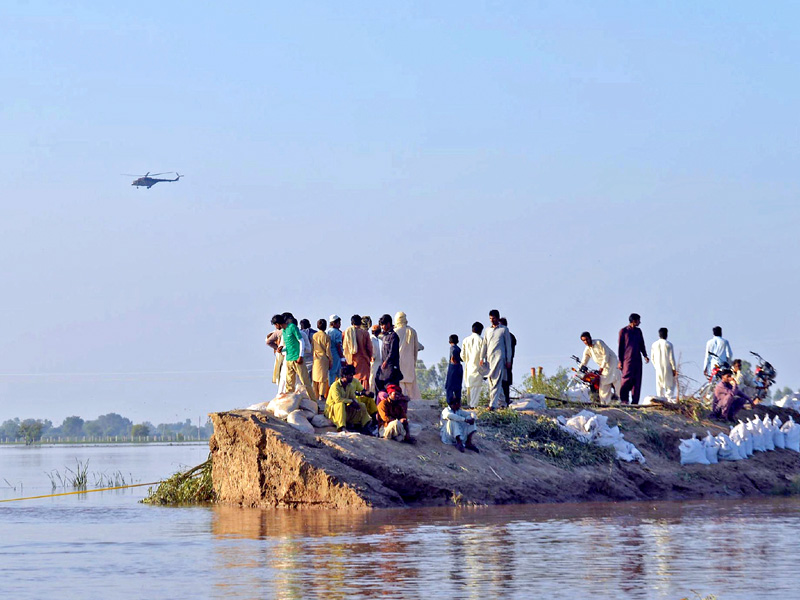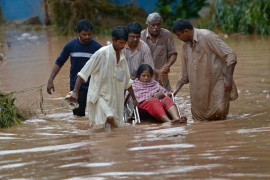
A deluge induced by heavy monsoon rains continues to wreak havoc in central Punjab as it heads south. Authorities in Jhang district raised alarm on Monday as the water level in Head Trimmu surged in the wake of an unprecedented flow in the Jhelum and Chenab rivers.
The district administration has chalked out a contingency plan to breach the Athara Hazari embankment to save the urban population of Jhang after ordering evacuation of Athara Hazari tehsil which comprises more than 250,000 spread across 260-plus villages.
“The capacity of Head Trimmu is 650,000 cusecs while it is expected to receive about 832,000 cusecs of water from the Chenab River and 525,000 cusecs from the Jhelum River,” said Chaudhry Muhammad Aslam Kamboh, the executive engineer of Head Trimmu.
He added that the floodwater from the Chenab River was two hours ahead of the Jhelum River. “If the two rivers maintain the distance, the administration can save the urban population, as well as Ahmad Pur Sial tehsil and adjoining areas from devastation. Otherwise, the situation will be out of control,” he added. The administration has already ordered the evacuation of Ahmad Pura Sial tehsil.
District Coordination Officer (DCO) Chiniot Dr Muhammad Irshad told The Express Tribune that a heavy flood torrent was rapidly heading towards Head Trimmu which would hit the area any time on Monday night.
He said about 758,000 cusecs of water flow was recorded in the Chenab River near Chiniot Monday morning. “Water level in the Chenab River was 820,980 cusecs at 6am; 842,000 cusecs at 9am; 850,000 cusecs at 12 noon; and 881,400 cusecs in the evening. The water level will increase to 925,000 cusecs when the flood torrent will reach Chiniot,” he added.
The DCO said that they have breached a drain near Harsa Sheikh to save the urban population. “At present, the floodwater is badly affecting crops, houses and other installations while an army helicopter has reached Chiniot to rescue people,” he added
The flood wreak havoc in Khushab, Shah Pura, Mid Ranjha, Miani and Sahiwal, where more than 120 villages were badly affected as water damaged 800 houses, leaving the local populace marooned. Chiniot-Bhowana Road was also closed due to the breach in the Saim Nallah Jhang Road which has affected more than 18 villages.
According to unconfirmed reports, 38 more people fell prey to the ravages of the flood across Punjab and Azad Jammu and Kashmir on Monday, taking the fatality toll to 357.
Danger of floods in Sindh
While the surge rampages through Punjab, Sindh is also likely to face flood as 800,000 to 10,00,000 cusecs of water will reach Sukkur Barrage on September 15 and 500,000 to 600,000 cusecs will reach Kotri Barrage on September 20-21, said officials from the Indus River System Authority (Irsa).
According to the officials, Pakistan is facing floods because India released a huge quantity of water in the Jhelum and Chenab rivers. Due to this influx, the water level in the Chenab at Head Marala rose from 27,000 cusecs to 900,000 cusecs whereas in the Jhelum River the flow swelled from 22,000 cusecs to 500,000 cusecs.
“India has also released 26,000 cusecs of water in the Sutlej River. However, water flows in the Kabul and Indus rivers have been normal,” one of the officials told The Express Tribune. “On September 13-14, it will reach Guddu Barrage on the Indus River where its flow will be 600,000 to 800,000 cusecs, causing floods in Sindh,” he added.
The heavy rain started on September 4 and continued till September 5-7. The official said Irsa had stored 50% water out of the total water flows and 50 per cent had gone downstream.
Relief efforts
The NDMA on Monday said it has stepped up its relief activities in flood-stricken areas and geared up its coordination with provincial authorities.
According to a press release, the NDMA has coordinated aviation rescue and relief efforts with the Pakistan Army, other agencies and district administration – to support evacuation of people from the flooded areas around the Chenab and Jhelum rivers. Nine helicopters are taking part in the rescue operation, it added.
The Pakistan army has established 54 relief camps and 73 mobile health camps in Gujranwala division where flood survivors are being provided shelter, food items and medical aid.
Balochistan declares flood emergency
The provincial government has declared a flood emergency in Naseerabad, Jaffarabad, Subatpur and Dera Bugti in order to cope with the situation, if flashfloods hit these areas.
Home Minister Sarfraz Bugti said there was a possibility that flashfloods would hit these districts on September 16 and 17. “The government is taking all precautionary measures to cope with the situation. The Provincial Disaster Management Authority (PDMA) and other departments are closely monitoring the situation,” Bugti told a news conference in Quetta.
Published in The Express Tribune, September 9th, 2014.
COMMENTS (8)
Comments are moderated and generally will be posted if they are on-topic and not abusive.
For more information, please see our Comments FAQ































1714024018-0/ModiLara-(1)1714024018-0-270x192.webp)









Blaming India without any solid proof is not good the water that flows is measured and noted at many places and the details for the period of floods must be released i.e. how much excess water India released . Actually the people in Jammu and Kashmir are also suffering due to extra ordinary rains, this natural calamity and it will be proper if we rise to help those who are facing the fury of nature instead of blame game.
@JUSTICE: Main reason is to get waiver for interest to be paid on loan. http://tribune.com.pk/story/762027/floods-and-the-invisible-spillover/
India tell Pakistan before releasing water towards Pakistan. This year Nawaz Sharif had some mutual understanding with India not to announce officially about the release of water so that the crowd gathered by Imran Khan and Dr, Tahir Ul Qadry go back to their homes due to flood. Also Nawaz sharif knew a huge amount will come as a donation which Nawaz Sharif instead of spending on flood affectees will use to fill his already filled accounts. This is true this was all plan by Nawaz Sharif. Nawaz also send mangoes to India after this flood. How can Nawaz be sincere for Pakistan and for Pakistanis
@Shuaib: You can file case in ICJ then and can claim huge penalties from India.
It is a natural calamity. Even Advanced Countries having state of art modern infrastructure face lot of difficulties in handling natural disasters.
People especially wealthy one should come forward to assist flood affectees.
We need enthusiasm more than that of October 08, 2005 earthquake.
Despite the fact that we build dams and take other precautionary measures to minimize the risk and manage the heavy flow of water we are blaming india for releasing too much water. If we cannot stop the floods atleast we can reduce the impact/severity of the damage caused by this natural disaster. Obviously i am not the first, last and only one to say this all .. but those charged with governance.. Have mercy on this nation guys .. maybe that will reduce the severity of the heat u r going to face on the judgement day ..
@Qabil Khan: India has not honoured the IWT.
If we can blame India for releasing ' a huge quantity of water in the Jhelum and Chenab rivers' then surely Sindh can, by the end of this week, blame Punjab for releasing a huge quantity of water into the province. It's time everyone grew up and accepted the fact that nature does not recognise geographical borders.